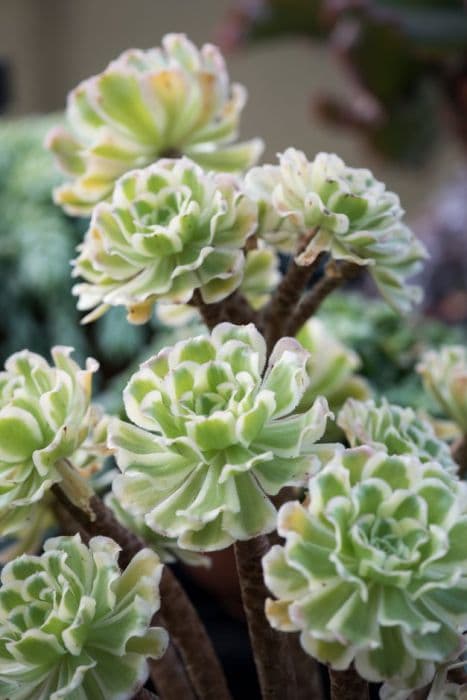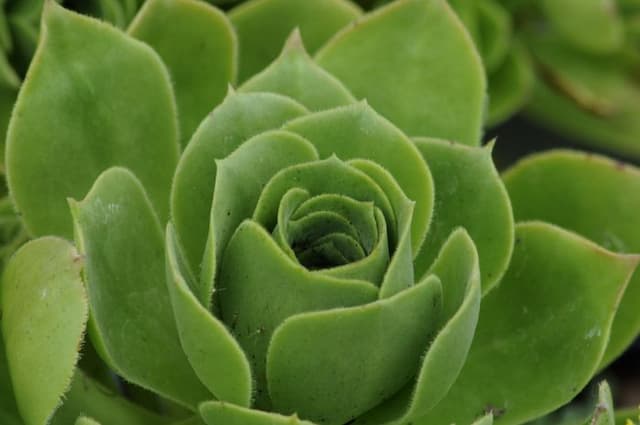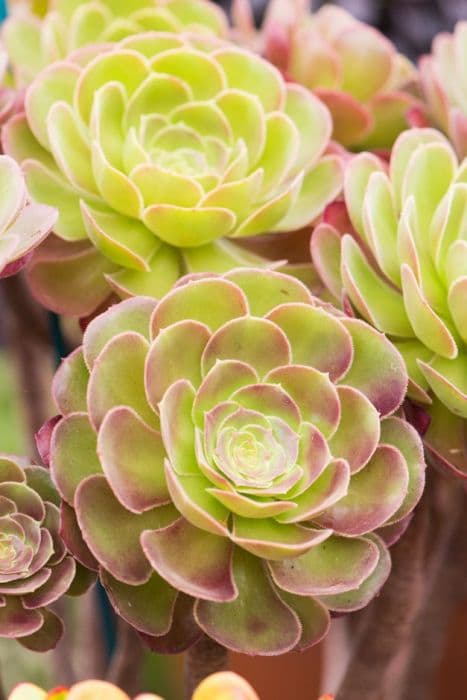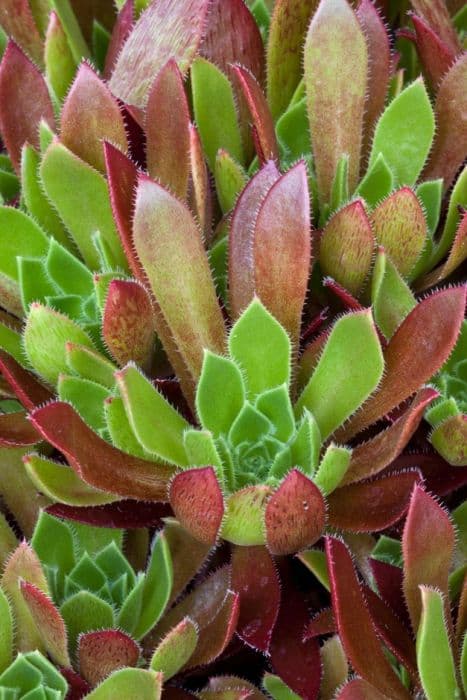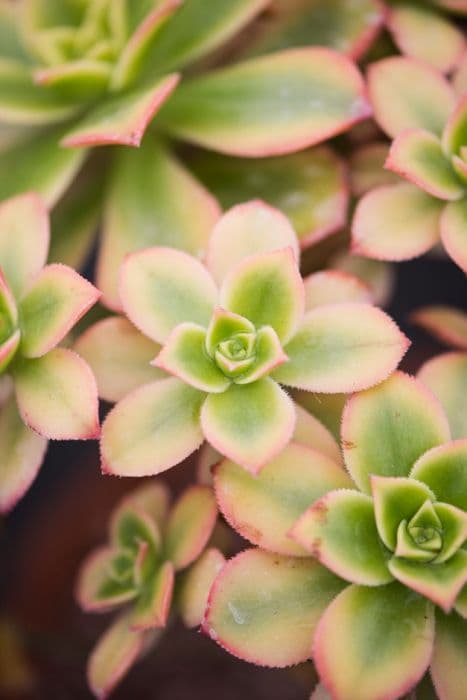Stonecrop Hylotelephium 'Bertram Anderson'
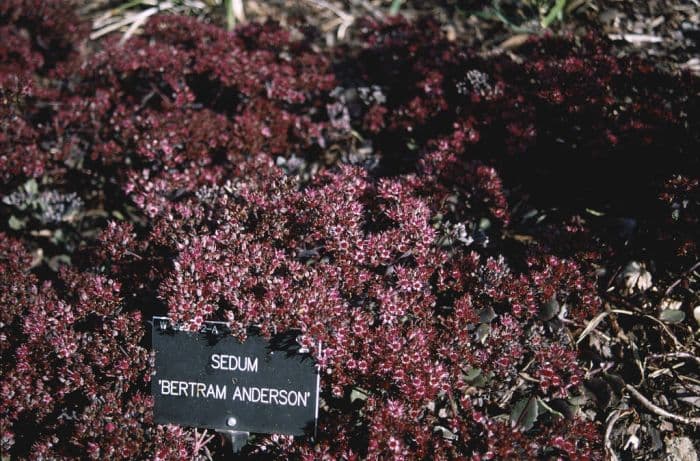
ABOUT
The plant in question, commonly known by the gardeners as the 'Bertram Anderson', is a striking succulent with a robust and attractive appearance. Its foliage is the most distinctive feature, showcasing thick, fleshy leaves that are often a deep purple or burgundy hue. These leaves are typically arranged in a dense, rosette-like pattern, giving the plant a full and rounded look. In the warmer months, the 'Bertram Anderson' produces clusters of small, star-shaped flowers that are usually a contrasting color to the leaves, such as a bright pink or magenta. These flowers, atop shorter stems, rise just above the foliage and add a significant pop of color to the plant's look. Overall, the contrast between the dark foliage and the vibrant flowers makes this plant a highly decorative and sought-after addition to any garden. It is often admired for its visual interest and the textural quality it brings to landscaping designs.
About this plant
 Names
NamesFamily
Crassulaceae
Synonyms
Stonecrop
Common names
Hylotelephium telephium 'Bertram Anderson', Sedum telephium 'Bertram Anderson'.
 Toxicity
ToxicityTo humans
Stonecrop plants, including the Hylotelephium 'Bertram Anderson', are generally not toxic to humans. However, it is always advisable to avoid ingesting any part of ornamental plants as a precautionary measure. If any part of the plant is ingested, it is unlikely to cause significant symptoms of poisoning.
To pets
Stonecrop, which Hylotelephium 'Bertram Anderson' is a variety of, is largely considered non-toxic to pets as well, including dogs and cats. While ingestion is not expected to cause serious harm, pets may experience mild gastrointestinal upset, such as vomiting or diarrhea, if they consume this plant in large quantities. It is always best to monitor your pets and prevent them from eating ornamental plants.
 Characteristics
CharacteristicsLife cycle
Perennials
Foliage type
Deciduous
Color of leaves
Purple
Flower color
Pink
Height
1 foot [30 cm]
Spread
1 foot [30 cm]
Plant type
Succulent
Hardiness zones
3
Native area
Europe
Benefits
 General Benefits
General Benefits- Easy to grow: Sedum 'Bertram Anderson' is known for being very low maintenance and easy to care for, making it perfect for novice gardeners.
- Drought tolerant: This plant is highly tolerant of dry conditions once established, requiring minimal watering.
- Attracts pollinators: The flowers attract bees, butterflies, and other beneficial insects, which can help pollinate your garden.
- Seasonal interest: It offers year-round visual interest with its colorful foliage and vibrant blooms in late summer to fall.
- Suitable for containers: It performs well in containers and can be used to decorate patios, balconies, or rooftops.
- Groundcover: Sedum 'Bertram Anderson' can be used as an effective groundcover that suppresses weeds and covers bare spots in the landscape.
- Edging plants: Their compact growth habit makes them ideal for use as edging along paths or garden borders.
- Rock gardens: This sedum variety is well-suited for rock gardens due to its tolerance of poor, rocky soils and its ability to thrive in crevices.
- Winter hardy: It is capable of withstanding cold temperatures, making it a suitable choice for many temperate climates.
- Propagation: The plant can easily be propagated from cuttings or leaves, which allows for easy expansion of your garden.
 Medical Properties
Medical PropertiesThis plant is not used for medical purposes.
 Air-purifying Qualities
Air-purifying QualitiesThis plant is not specifically known for air purifying qualities.
 Other Uses
Other Uses- Hylotelephium 'Bertram Anderson', commonly known as stonecrop, can be used in miniature gardens or fairy gardens due to their small size and attractive foliage, acting as tiny trees or bushes in these whimsical landscapes.
- Stonecrop leaves can be used as a modest natural dye for fabrics, giving them a greenish hue when processed properly.
- The plant is suitable for use in green roofing, contributing to energy efficiency and habitat creation for urban wildlife.
- Stonecrop can serve as an indicator plant for gardeners, as it tends to wilt during drought conditions, signaling the need for watering.
- The succulent nature of stonecrop makes it a valuable addition for fire-resistant landscaping, as it contains moisture and can help in slowing down fires.
- This plant's interesting texture and color can be used in floral arrangements, particularly in modern or rustic-themed decor.
- Stonecrop can be planted in cracks and crevices of stone walls or walkways, where it can enhance the aesthetics while stabilizing the structure with its roots.
- The thick leaves of stonecrop can be used in art projects, such as leaf casting, to create decorative concrete garden ornaments.
- During winter, the dried seed heads of stonecrop provide visual interest in the garden and can be coated with bird-safe paint or glitter for additional decorative effect.
- Stonecrop is sometimes used in education for lessons on drought tolerance and water conservation due to its low water needs and survival strategies.
Interesting Facts
 Feng Shui
Feng ShuiThe plant Stonecrop is not used in Feng Shui practice.
 Zodiac Sign Compitability
Zodiac Sign CompitabilityThe plant Stonecrop is not used in astrology practice.
 Plant Symbolism
Plant Symbolism- Resilience: Hylotelephium 'Bertram Anderson', commonly known as Stonecrop, is highly resilient and drought-resistant, symbolizing the ability to thrive in challenging conditions.
- Survival: Stonecrop can survive in poor soil and still produce beautiful flowers, representing endurance and the ability to overcome adversity.
- Adaptability: Given its ability to adapt to various climates and environments, Stonecrop symbolizes flexibility and the capacity for change.
- Longevity: With its perennial nature, Stonecrop exemplifies longevity and persistence through the seasons.
- Peace: The soothing and subtle colors of Stonecrop flowers often evoke a sense of tranquility and calm, making it a symbol of peace.
 Water
WaterStonecrop 'Bertram Anderson' should be watered deeply but infrequently, as it is drought tolerant. During the growing season, water approximately once per week, allowing the soil to dry out between waterings. Provide about one gallon of water for outdoor plants or two to four ounces for smaller potted specimens each time you water. In the winter, reduce watering to once a month, as the plant requires less moisture during its dormant period.
 Light
LightStonecrop 'Bertram Anderson' thrives in full sun, where it receives at least six hours of direct sunlight daily. The ideal spot for this plant would be in a south-facing garden bed or by a sunny window if grown indoors. Partial shade is tolerable, especially in extremely hot climates, but too much shade can lead to leggy growth and fewer blooms.
 Temperature
TemperatureStonecrop 'Bertram Anderson' is hardy and can tolerate temperatures from well below freezing up to around 90 degrees Fahrenheit. However, the ideal growing temperature range for this plant is between 65 and 75 degrees Fahrenheit. It can survive brief periods of colder or hotter weather, but prolonged exposure to extreme temperatures may harm the plant.
 Pruning
PruningStonecrop 'Bertram Anderson' benefits from pruning to maintain its shape and to remove any dead or damaged stems. It's best to prune the plant in early spring before new growth begins. You can also trim back the plant after flowering is over to keep it compact. Pruning can be done annually, as this will also help to encourage fuller growth and more vibrant blooms in the upcoming season.
 Cleaning
CleaningAs needed
 Soil
SoilStonecrop requires well-draining soil with a pH ranging from slightly acidic to neutral. A mix of potting soil, coarse sand or perlite, and compost works well for optimal growth. Ensure the soil allows for proper drainage to prevent root rot.
 Repotting
RepottingStonecrop should be repotted every two to three years, or when it has outgrown its current pot. Repotting should be done in the spring or early summer when the plant is actively growing.
 Humidity & Misting
Humidity & MistingStonecrop thrives in average household humidity levels and does not require high humidity. It prefers a drier environment, so ensure good air circulation around the plant to maintain appropriate humidity conditions.
 Suitable locations
Suitable locationsIndoor
Place stonecrop in bright light and ensure the container has drainage holes.
Outdoor
Plant in sunny spot with well-draining soil; tolerate drought and poor soil.
Hardiness zone
3-9 USDA
 Life cycle
Life cycleHylotelephium 'Bertram Anderson', commonly known as Stonecrop, begins its life cycle as a seed sown in soil with good drainage and exposure to full sun to partial shade. Upon germination, which may vary in time depending on environmental conditions, it develops a small rosette of succulent leaves close to the ground. As it grows, it enters a vegetative stage where the fleshy leaves become larger and the plant expands through underground stems or rhizomes. Stonecrop flowers in late summer to fall, producing clusters of star-shaped flowers at the tips of its stems; this is when it attracts pollinators for sexual reproduction. After pollination and seed set, the plant often goes dormant in winter, with above-ground parts dying back, only to re-emerge from its roots in spring. Finally, the plant completes its life cycle when seeds are dispersed, and it may also propagate vegetatively by division or from cuttings taken during the active growth period.
 Propogation
PropogationPropogation time
Spring-Early Summer
Hylotelephium 'Bertram Anderson', more commonly referred to as Stonecrop, can be propagated most effectively through stem or leaf cuttings. The ideal time for taking cuttings is in the spring or early summer when the plant is actively growing. To propagate through stem cuttings, a healthy stem should be selected and a piece of about 2 to 4 inches (5 to 10 cm) in length is cut off. The cut end is then allowed to callous over for a few days to prevent rot when planted. Once calloused, the stem can be placed in well-draining soil, keeping the soil slightly moist until the cutting has rooted, which typically takes a few weeks. After rooting, it can be treated as a mature plant. Propagation through leaf cuttings follows a similar process, where a single leaf is detached and left to callous before being placed on soil for rooting.
